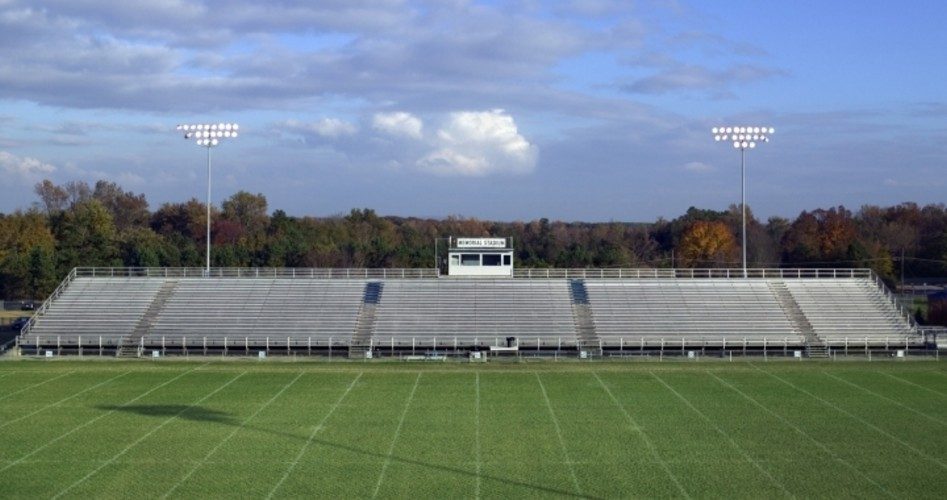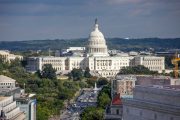
You know you’re in mass hysteria’s grip when actions taken to combat a problem don’t bear any relationship to reality. So it is with the Wuhan coronavirus, with, for example, schools shut down even though we’ve long known there’s virtually no risk of children either dying from or spreading the disease. Then there’s another example:
Not “one high school, college or professional athlete in the country has died from COVID-19,” writes Uncoverdc.com’s Bill Rice.
In fact, “in the seven months this virus is said to have been circulating in America, the probability a high school, college, or pro athlete will die from COVID-19 has been exactly 0-in-8,500,000,” he continues. “(If I missed one or two fatalities, these odds would decrease to 1-in-8.5 million or 2-in-8.5 million).”
Nonetheless, we’re still accosted with propagandistic, sky-is-falling reportage such as, as Rice puts it, “eight Crimson Tide players and three Auburn Tigers have tested ‘positive’ for COVID-19,” absent the perspective that these athletes are generally asymptomatic — and that asymptomatic positives are a good thing.
Eight PGA golfers also tested positive since the season’s resumption, Rice relates, and implicit in such facts’ reporting is that we should question whether we “opened” too soon.
Of course, this goes beyond sports: Whether at issue is Florida, Sweden, or some other place with the temerity to not cower in a sterile bubble and give every proximate object a Silkwood-intensity scrub-down, the message is that increasing positive virus cases vindicate the lockdown “strategy.”
You’re supposed to forget that the pretext for the lockdowns was to prevent healthcare-system overload by reducing the contagion rate; in fact, experts stated from the get-go that lockdowns would not reduce the number of cases (the number of “positives”) over the long term.
Yet now, with models factoring in mitigation measures long ago having been revealed as greatly overestimating healthcare strain, a switcheroo has been pulled: We are supposed to believe that lockdowns were meant to prevent long-term virus spread.
Yet according to Rice, some studies find that up to 80 percent of the virus-infected are asymptomatic. To the point here, based on his sports-page research, he writes that he’d “estimate at least 90 percent of these [infected] athletes were “asymptomatic.”
This isn’t surprising. We’ve known ever since early statistics emerged from Italy that the virus is deadly mainly to the elderly and those with comorbidities; in fact, 40 to 50 percent of our Wuhan virus deaths have occurred in nursing homes (partially because certain Democrat governors seeded them with virus-positive patients) even though they house a mere 0.42 percent of our population. In contrast, athletes are young and the healthiest among us.
Despite this, few, if any, of the stories about whether there should be college football this season “mention the one statistic that would seem to be most germane to the topic,” Rice laments. “Namely, not one high school, college or professional athlete in the country has died from COVID-19.”
And is it rational to even discuss halting an activity over a “threat” involving a mortality risk approaching zero?
Of course, a player could die. Regarding football, however, “if the possibility that one or two players might die due to their participation in this sport carried great weight,” Rice astutely points out, “football would have been abolished 120 years ago.”
“Every year approximately 12 players die from playing the game,” Rice continues. “On top of this, hundreds of thousands of participants suffer injuries that send them to a doctor or a hospital.”
While this is one reason parents increasingly frown upon football, note that children die every year playing baseball, too, and while engaging in a host of other activities.
Moreover, parents who’d push their kids toward the solitary activity of bicycling to avoid viral infection should know that this pastime claims hundreds of young lives yearly.
The bottom line is that with many group activities, your child has a greater chance of dying due to the activity itself than from contracting the Wuhan virus during the activity.
Apropos here is a truth expressed via a twist on a Frédéric Bastiat line: The bad analyst confines himself to the visible effect; the good analyst considers both the effect that can be seen and that which must be foreseen. As to this, Rice also points out that suspending sports has many negative effects on the lives of those involved in it, not the least of which is that these activities can’t keep at-risk youths out of trouble when they’re suspended.
Yet the same can be said of lockdowns’ effect on society in general. Studies have shown that not only don’t these measures save lives, but that they can actually cause more death than the pandemic would.
If only media would consider this when ominously reporting on “positive cases” — ignoring that it’s hospitalization and mortality rates that matter and that viral spread can lead to herd immunity — a profoundly foolish fixation unprecedented historically.
As an example, according “to author John M. Barry’s account of the ‘Spanish Flu,’ it wasn’t people testing positive for influenza that alarmed the masses; it was the large swaths of people spanning all age categories who actually became sick and often died,” relates Rice. “Indeed, in 1918-19 young adults died in ‘extraordinary’ numbers, according to Barry.”
“This has certainly not happened with the COVID-19 pandemic of 2020,” Rice continues.
No, but sanity has died. With BLM kneeling and squealing all the rage in some quarters, there may be good reason to desire a permanent halt to certain professional sports. But worrying about your child dying from the Wuhan virus contracted during sports, or some other way, is about as rational as permanently ensconcing him in a grounded enclosure for fear of a lightning strike.
Image: Thinkstock
Selwyn Duke (@SelwynDuke) has written for The New American for more than a decade. He has also written for The Hill, Observer, The American Conservative, WorldNetDaily, American Thinker, and many other print and online publications. In addition, he has contributed to college textbooks published by Gale-Cengage Learning, has appeared on television, and is a frequent guest on radio.



